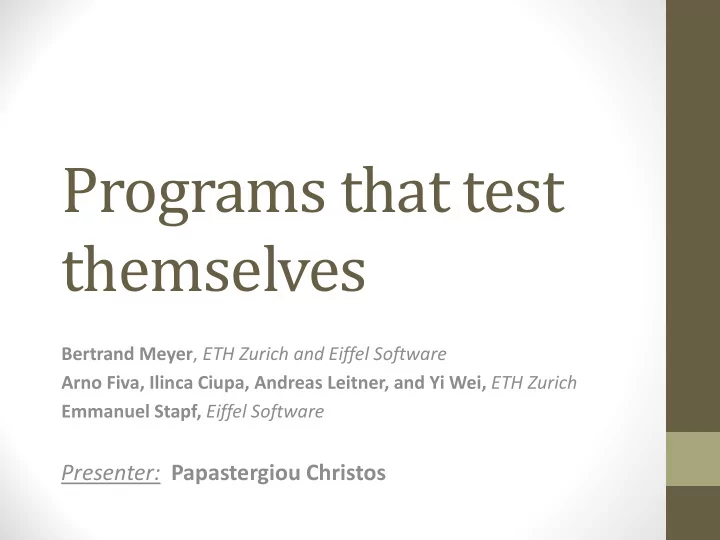

Programs that test themselves Bertrand Meyer , ETH Zurich and Eiffel Software Arno Fiva, Ilinca Ciupa, Andreas Leitner, and Yi Wei, ETH Zurich Emmanuel Stapf, Eiffel Software Presenter: Papastergiou Christos
Introduction Modern engineering products continuously test themselves They are designed for testability Software design pays little attention to testing needs Idea: Design software for testability
Autotest Autotest is a set of components that automates testing process relies on programs with contracts is integrated into the EiffelStudio Components test generation test extraction integration of manual tests
Automated testing Levels of automation: test execution (JUnit, PHPunit …) regression testing resilience test case generation test oracles minimization Most frameworks support only the first three Autotest innovates also on the last three
Test generation The unit of a generated test is a failed routine call Each routine is exercised with different targets and arguments Use contracts as oracles Log results Create minimized tests for the failed routines
Exercising a routine (1) Objects are needed for target and possibly for arguments When an object T is needed, Autotest decides: to create a new one to use an existing one To create a new object Autotest selects a constructor makes sure invariant holds
Exercising a routine(2) The arguments of a routine might be of primitive types. Autotest decides: random selection from the domain selection from preset values for each type Random but still powerful
Contracts as oracles Contracts in the code serve as oracles A contract violation signals a flaw either in: the caller of a routine or in the routine itself Benefits software is tested as it is no further programming skills needed
Optimizations Adaptive random testing use values equally spaced out across a domain introduction of a distance metric for objects complements rather than replaces the random algorithm Routine exercising using ART ba3.transfer(ba1, i5) ba1.transfer(ba4, i2) ba2.transfer(ba2, i4) … Objects pool
Minimization Keeping the whole failed test is impractical Keep only the instructions that involve the target and the arguments of the failing routine statically analyze the failed test calculate backward slice use the slice as the failed test Initial test Minimized test
Test generation results Autotest was experimented on classes with different semantics and sizes Tested library Faults Percent failing Percent failed routines tests EiffelBase 127 6.4 (127/1984) 3.8 (1513/39615) Gobo libraries 26 4.4 (26/585) 3.7 (2.928/79886) Specification 72 14.1 (72/510) 49.6 library (12860/25946)
Test extraction Failed runs are candidate test cases Autotest can turn a failure into a test by 1. creating a trace abstraction of the debugger (a called_by tree with <invocation,context> nodes) 2. selecting the invocation that received the failure 3. extracting a snapshot of the state that is required for this invocation
Demo
Conclusions Advantages nice features on automatized testing discovers unfound software failures helps investigate questions does not require extra knowledge all tests are treated the same regardless of their origin Disadvantages cannot guarantee absence of faults not suitable for integration testing generated and extracted tests less robust and readable Manual tests should still form the majority of your testing suite!
Questions?
Demo – Bank Account Class
Demo – Manual Test Case
Demo – Test Execution
Demo – Application Class
Demo – Failed Execution
Demo – Test Extraction
Demo – Extracted Test
Demo – Test Generation
Demo – Generated Test
Recommend
More recommend